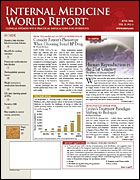Publication
Article
Internal Medicine World Report
A Shifting Epidemic: The CDC Gears Up to Eliminate Syphilis
Author(s):
Physicians' Prevention Role
JACKSONVILLE, Fla?Data from a large, national, population-based study of syphilis prevalence presented at the Centers for Disease Control and Prevention (CDC) 2006 National STD Prevention Conference show a disproportionate impact of syphilis on blacks in the United States. Additional studies presented at the conference provide important insights into infection risk among men who have sex with men (MSM) and outlines directions for preventive efforts in this population.
"Every year, an estimated 19 million sexually transmitted disease [STD] infections occur in the United States, and half of these occur among people under the age of 25," said John M. Douglas, MD, director of the CDC's Division of STD Prevention. "Syphilis has been reduced to extremely low levels in this nation, making it possible to eliminate this disease as a health threat in the United States."
Since the CDC launched its syphilis elimination campaign in 1999, the rates of infection with syphilis among blacks have declined by 37%, and the "racial gap in syphilis cases has narrowed significantly," he noted. The ratio of black-to-white syphilis rates declined from almost 29:1 in 2000 to roughly 6:1 in 2004. Among women, the rates of syphilis overall fell by 60% and of congenital syphilis by 39%.
But this trend does not apply to all populations in this country. In certain subgroups, syphilis is still prevalent, and ?rates are increasing, Dr Douglas said. "Despite the remarkable progress in many areas, we also face significant challenges, and the overall national rate of syphilis has been increasing over the last 4 years." ?
This increase has been driven largely by a higher incidence in MSM. "Rates among men overall increased by 68% from 1999 to 2004, and now 64% of all adult cases are estimated to be among MSM, up from just 5% in 1999," Dr Douglas said. "Clearly the epidemic has shifted and so must our prevention efforts."?
In Chicago, syphilis infections among MSM increased by 87% between 2004 and 2005, according to a study by that city's Department of Public Health. MSM accounted for 73% of cases in the city in 2005, a sharp increase from just over half (54%) of all cases in 2004.
A new CDC study that analyzed data collected between 2001 and 2004 from a nationally representative household survey of >5700 people showed that while just 0.71% of Americans between the ages of 18 and 49 had been infected with syphilis at some point of their lives, 4.3% of blacks in this age-group had been infected. Blacks were significantly more likely than whites (0.07% infected) and Mexican-Americans (0.98% infected) to have had the disease.
Kevin Fenton, MD, director of the CDC's National Center for HIV, STD, and TB Prevention, believes that elimination of syphilis is possible because of the generally low levels of this STD in the population, the CDC's ability to pinpoint the areas where infection still exists through surveillance, and the effective treatments that can control the disease once it is diagnosed. ?
"Syphilis is also largely concentrated in a small number of geographic areas, with the majority of the US counties reporting no cases at all in 2004," Dr Fenton noted, adding that "more than 50% of infectious syphilis cases were reported from just 20 counties in the United States," as shown in the Figure below.
These 20 counties tend to contain larger, urban areas on both the East and West coasts, as well as in the Southeastern United States. "These are the counties which are associated with either dense populations or economic disparities. These counties also tend to have higher populations of either MSM or ethnic minority communities who are at increased risk of acquiring infectious syphilis," said Dr Fenton.
In an effort to revamp its prevention plan, the CDC has launched a new syphilis elimination program called "Together We Can: The National Plan to Eliminate Syphilis from the United States." It updates the CDC's 1999 recommendations to ensure that the progress is continued among blacks and other originally targeted populations, while new strategies are designed to reverse the rising tide of syphilis among MSM.
Another program, launched in San Francisco in 2004, is the Internet Sexuality Information Services (ISIS). With its online site-www.inSPOT.org -which was developed with the San Francisco Department of Public Health, it is already making an impact and is expected to be further instrumental as it expands to other cities. The website allows patients to anonymously notify past partners that they have been exposed to an STD. ?
More than 30,000 men have already used the website to send illustrated e-cards with personalized messages urging partners to be tested for STDs (see e-card). Physicians are encouraged to inform their patients with syphilis about this site and urge them to notify any relevant partner of their infection.?
Deborah Levine, executive director of ISIS, noted that while the service cannot replace talking to one's partner or in-person communication, it is "one more tool in the toolkit so that people can be responsible to them-selves and the community to stop STD transmission."
KEY POINTS
Although syphilis rates have declined in many places in the country, the overall rates have increased significantly in the past 4 years.
Encourage your patients to inform their present/past partners of the need to be tested for STDs.
Also mention that they could use an anonymous e-card from www.inSPOT.org if they wish to maintain their anonymity.





